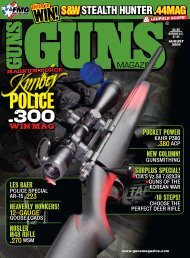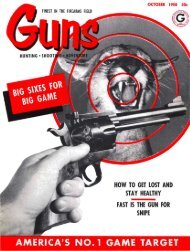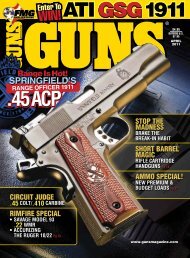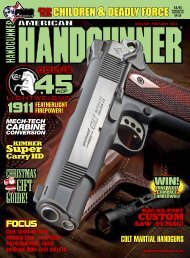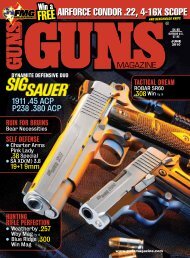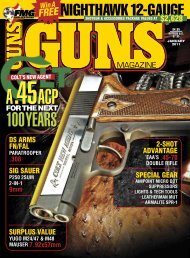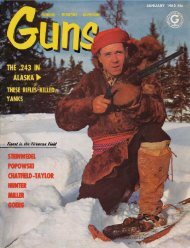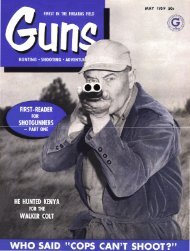Guns 2012-08.pdf - Jeffersonian
Guns 2012-08.pdf - Jeffersonian
Guns 2012-08.pdf - Jeffersonian
You also want an ePaper? Increase the reach of your titles
YUMPU automatically turns print PDFs into web optimized ePapers that Google loves.
STORY: Massad Ayoob<br />
Trigger Control<br />
Part V: The Back to Basics Series<br />
Trigger control is a non-negotiable key to accurate<br />
shots, and there are different ways to accomplish it,<br />
at different speeds. The first World Champion of Combat<br />
Pistol Shooting, Ray Chapman, was one of my mentors. He<br />
famously said, “Pistol shooting is simple… it just isn’t easy.”<br />
In all the years since I was privileged to work with him, I’ve<br />
never seen anything to credibly contradict his statement.<br />
If you ever saw my video<br />
StressFire, Part I, Handgun, you<br />
heard me say trigger control was<br />
“the heart of the beast” in terms of<br />
getting good hits under pressure with<br />
a pistol or revolver. I haven’t seen<br />
anything lately to contradict that,<br />
either.<br />
Once the firearm is aligned with<br />
the target, we need to bring the<br />
trigger straight back without exerting<br />
pressure in any direction that will<br />
deviate the muzzle from point-ofaim,<br />
until the shot “breaks.” Over the<br />
years, lots of folks have experimented<br />
with “staging” the trigger, a 2-step<br />
event in which the finger first takes<br />
up most of the trigger’s movement,<br />
and then performs a second,<br />
separate press to break the shot. It<br />
sounded great in theory, but doesn’t<br />
have a great history in practice. We<br />
in the gun world all seem to agree<br />
that once the decision to fire the shot<br />
has been made, the exact instant of<br />
the shot should come as a surprise,<br />
so we don’t subconsciously say to<br />
ourselves, “Now!” and convulsively<br />
jerk the trigger, pulling the muzzle—<br />
and the shot—away from where we<br />
intended it to hit.<br />
In earlier segments of this “back<br />
to basics” series, we’ve talked about<br />
grasp, trigger finger placement, etc.<br />
At the moment, we’re talking about<br />
that simple-but-not-easy rearward<br />
press of the trigger that allows the<br />
shot to fire while the gun is aligned<br />
with what we want to hit.<br />
Three Approaches<br />
Bearing in mind that under stress<br />
we experience vasoconstriction, a<br />
redirection of blood flow away from<br />
the extremities and into the major<br />
muscle groups and internal organs, it<br />
has long been understood fine motor<br />
coordination will go down the toilet,<br />
but physical strength will increase<br />
to levels we just can’t duplicate in<br />
training. We have to keep this in<br />
mind when we consider how we’ll<br />
fire a handgun at the range, or at a<br />
match, versus in defense of human life<br />
including our own under predictably<br />
high stress. Let’s look at three ways to<br />
“pull a trigger.”<br />
Trigger slap is generally considered<br />
the mark of the rank amateur. The<br />
shot is fired… you can almost hear<br />
the psychic scream of “Eek! It went<br />
bang!” … and the finger flies forward<br />
away from the trigger, occasionally<br />
bouncing off the front of the<br />
triggerguard. Now, for the next shot, it<br />
comes back with impact, and jerks the<br />
muzzle violently off target, causing a<br />
bad hit at best and a miss at worst.<br />
However, there is such a thing as a<br />
“controlled trigger slap.” You can see<br />
Bill Wilson doing it, back when he was<br />
a kick-butt pistol champion before<br />
he devoted himself to gunmaking,<br />
in ESPN videotapes of Bianchi Cup<br />
from the 1980s. World champion Rob<br />
Leatham pioneered the controlled<br />
trigger slap on close, fast targets<br />
in matches where hundredths of a<br />
second distinguished the winner.<br />
However, Rob is also famous for<br />
using a 1-pound trigger pull 1911 in<br />
competition, a trigger pull he himself<br />
has publicly admitted one would have<br />
to be nuts to have on a self-defense<br />
pistol.<br />
“Riding the link,” also known as<br />
“riding the sear,” is at the opposite<br />
end of the trigger pull bell curve.<br />
When “riding the link,” (above) the finger<br />
comes just far enough forward from the last<br />
shot to feel the trigger “reset.” Daylight<br />
between finger and trigger show “slap” (below)<br />
about to take place. Useful very close and<br />
fast, but the technique is hard to learn to do<br />
with control.<br />
Developed for match shooting, this is<br />
a technique in which we allow the auto<br />
pistol’s trigger to come just far enough<br />
forward to reset the sear. In theory—<br />
and in calm coolness—it’s a great idea.<br />
Unfortunately, it’s incompatible with<br />
that whole “fight or flight response”<br />
thing and the vasoconstriction: stressnumbed<br />
fingers will no longer have<br />
the fine motor coordination to bring<br />
the trigger exactly so far forward, and<br />
no farther. I’ve seen world champions<br />
try to do this and blow it—the trigger<br />
not coming far enough forward to<br />
reset—and futilely pull on something<br />
that wasn’t ready to be pulled yet.<br />
They lost their matches. On the street,<br />
they might have lost their lives.<br />
Trigger weld is the third option,<br />
which at least from the defensive side<br />
of things seems to make the most<br />
sense. Allow the trigger to return<br />
all the way forward—which is “do-<br />
20<br />
WWW.GUNSMAGAZINE.COM • AUGUST <strong>2012</strong>




